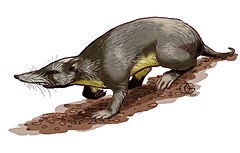West Indies shrews
| Nesophontes | |
|---|---|
 |
|
| Nesophontes edithae | |
|
Extinct (early 16th century)
|
|
| Scientific classification | |
| Kingdom: | Animalia |
| Phylum: | Chordata |
| Class: | Mammalia |
| Order: | Eulipotyphla |
| Family: |
†Nesophontidae Anthony, 1916 |
| Genus: |
†Nesophontes Anthony, 1916 |
| Species | |
|
†Nesophontes edithae |
|
†Nesophontes edithae
†Nesophontes hypomicrus
†Nesophontes longirostris
†Nesophontes major
†Nesophontes micrus
†Nesophontes paramicrus
†Nesophontes submicrus
†Nesophontes superstes
†Nesophontes zamicrus
Nesophontes, sometimes called West Indies shrews, is a genus of the extinct mammal family Nesophontidae in the order Eulipotyphla. This is the only genus described for this family. These animals were small insectivores, about 5 to 15 cm long, with a long slender snout and head and a long tail. They were endemic to Cuba, Hispaniola (Dominican Republic and Haiti), Puerto Rico, the United States Virgin Islands, and the Cayman Islands.
Although reliable estimates are unavailable, these animals are widely believed to have survived the Pleistocene extinction since remains have been found among those of Rattus and Mus species. Some authorities estimate extinction coinciding with the arrivals of rats aboard Spanish vessels in the early 16th century (1500). Others, such as Morgan and Woods, claim that some species survived until the early 20th century. A phylogenetic study in 2016, based on DNA extracted from a specimen about 750 years old, suggests their nearest relatives are the solenodons, although the two groups diverged more than 40 million years ago.
...
Wikipedia
